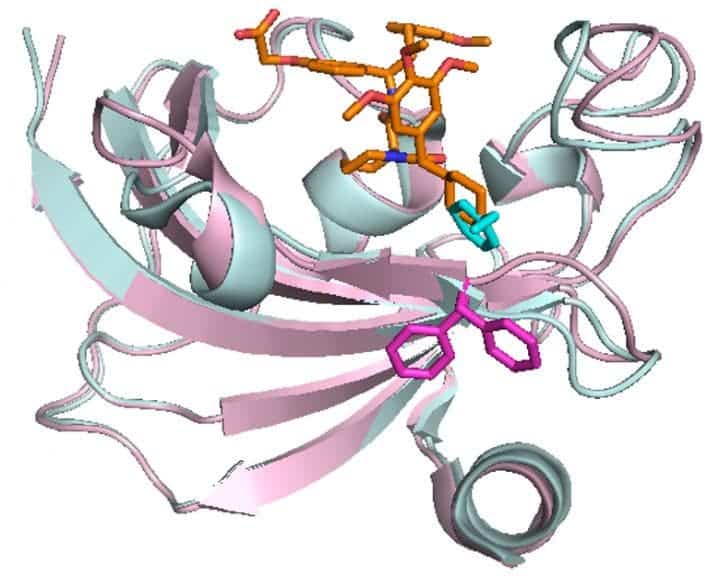New research aims to shut down a protein linked to major depression, obesity, and chronic pain.

The new inhibitor (colored orange) only blocks the activity of FKBP51, which is involved in depression, chronic pain and obesity.
Image credits Felix Hausch.
One protein known as FK506-binding protein 51, or FKBP51 for short, has previously been linked to depression, obesity, diabetes, and chronic pain. A new study is looking into ways we can block its activity in mice, in an effort to relieve chronic pain and have positive effects on diet-induced obesity and mood. The new compound could also have applications in alcoholism and brain cancer, the team explains.
The problematic protein
“The FKBP51 protein plays an important role in depression, obesity, diabetes and chronic pain states,” says Felix Hausch, Ph.D., the project’s principal investigator.
“We developed the first highly potent, highly selective FKBP51 inhibitor, called SAFit2, which is now being tested in mice. Inhibition of FKBP51 could thus be a new therapeutic option to treat all of these conditions.”
Hausch said he became “intrigued” by the protein’s peculiar role in the body, especially its link to depression. So, together with his team, he set about trying to shut it down. Among others, the protein can limit glucose uptake in cells and the browning of fat, which, taken together, can make our bodies store adipose tissue instead of shedding it. It also has a part to play in regulating our stress responses, Hausch adds, so finding a way to block FKBP51 could help treat a variety of conditions.
But here’s the catch: FKBP51 is extremely similar in structure to FKBP52, even though they perform almost opposite roles in cells. It is exceedingly difficult, then, to develop a drug that interacts with only one of these proteins and not the other. To tackle this issue, the team used nuclear magnetic resonance techniques to look at the FKBP51 protein, and discovered a new binding site.
“We have this yin-yang situation,” Hausch says. “Selectivity between these two proteins is thought to be crucial, but this is hard to achieve since the two proteins are so similar. We discovered that FKBP51 can change its shape in a way that FKBP52 can’t, and this allowed the development of highly selective inhibitors.”
Based on their analysis, the team started developing SAFit2, a substance they say could work to inhibit the activity of FKBP51 — and only FKBP51. Animal testing revealed that SAFit2 can help mice “cope better in stressful situations”, Hausch reports. It reduced stress hormone levels, promoted more active stress coping, was synergistic with antidepressants, protected against weight gain, helped normalize glucose levels, and reduced pain in three animal models.
Besides SAFit2, the approach they developed could help other researchers identify similar “cryptic” binding sites in challenging drug targets in the future, Hausch says.
The findings so far are pretty exciting, the team explains, but much more work needs to be done before we have FKBP1 inhibitors that are safe to use in human tests. Until then, they are exploring the potential applications of such compounds in animals. They’re also interested in using such inhibitors to treat alcoholism and have already started digging into this idea, but the results are still too early to report on.
Hausch also says that certain types of glioblastoma tumors overexpress FKBP51. This suggests that FKBP51 inhibitors might be used to treat cancer in patients whose tumors mutate beyond what current medication can treat.
“We may be able to resensitize them to different types of chemotherapy using these specific inhibitors,” he says.
The findings have been presented at the American Chemical Society (ACS) Spring 2019 National Meeting & Exposition under the title “Selective FKBP51 inhibitors enabled by transient pocket binding.”









